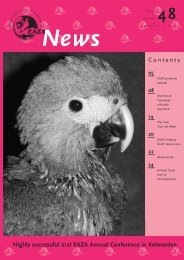EAZA News 57-12 - European Association of Zoos and Aquaria
EAZA News 57-12 - European Association of Zoos and Aquaria
EAZA News 57-12 - European Association of Zoos and Aquaria
Create successful ePaper yourself
Turn your PDF publications into a flip-book with our unique Google optimized e-Paper software.
eaza news <strong>57</strong><br />
2007<br />
20<br />
births <strong>and</strong> hatchings<br />
Berlin germany source<br />
press releases <strong>and</strong> bernhard blaszkiewitz<br />
The last rhinoceros to be born during the <strong>EAZA</strong><br />
Save the Rhino Campaign year was welcomed<br />
in Berlin Zoo just before Christmas 2006.<br />
A black rhino (Diceros bicornis) was born<br />
on 20 December after an almost 15 months<br />
pregnancy. Eleven-year-old female ‘Kumi’ is a<br />
first-time mother <strong>and</strong> is taking good care <strong>of</strong><br />
her female <strong>of</strong>fspring ‘Zawadi’. The 15-year-old<br />
male ‘Jasper’ sired the <strong>of</strong>fspring. Berlin Zoo<br />
has been very successful in breeding black<br />
rhinos over the years, with 14 animals born<br />
since 1981.<br />
The hatching <strong>of</strong> a James flamingo<br />
(Phoenicopterus jamesi) was one <strong>of</strong> the most<br />
exciting avian births at Berlin Zoo in 2006.<br />
This species bred for the first time in captivity<br />
Arnhem the netherl<strong>and</strong>s<br />
A successful exchange <strong>of</strong> epaulette sharks<br />
(Hemiscyllium ocellatum) resulted in a second<br />
captive generation. This is a very attractive<br />
shark species with a maximum size <strong>of</strong> 1 m, but<br />
is not commonly held in captivity. Besides two<br />
very large shoulder spots that resemble the eyes<br />
<strong>of</strong> a large animal it has a peculiar behaviour.<br />
When the shark wants to move to another<br />
place it does not swim but walks with its pelvic<br />
<strong>and</strong> pectoral fins, as if it is an amphibian. Two<br />
female epaulette sharks were born at Burgers’<br />
Zoo in 2000. In 2006 one <strong>of</strong> the captive born<br />
females was exchanged with a wild born male<br />
from Berlin Zoo to form a pair at Berlin Zoo<br />
with another male <strong>and</strong> a pair at Burgers’ Zoo.<br />
At Burgers’ Zoo the animals were placed in a<br />
5000 l aquarium behind the scenes. Sharks use<br />
different reproductive modes. Depending on<br />
the species, they are viviparous (give birth to<br />
life young), ovoviviparous (lay eggs in the<br />
mother <strong>and</strong> then give birth to life young) or<br />
oviparous (lay eggs). The epaulette shark is<br />
oviparous.<br />
After three months the first egg was laid, <strong>and</strong><br />
every eight to 14 days two eggs were produced.<br />
A total <strong>of</strong> thirty were laid, <strong>of</strong> which 80% were<br />
fertile. After 119 days the first young hatched,<br />
which was 15 cm in size.<br />
in Berlin in 1989, with a second chick hatching<br />
in 2001, some <strong>12</strong> years later. The small colony<br />
<strong>of</strong> seven birds, kept together with six Andean<br />
flamingos (Phoenicoparrus <strong>and</strong>inus) has<br />
The young do not eat for the first few days<br />
while absorbing the internal yolk, <strong>and</strong> this<br />
shark took seven days before eating its first<br />
meal <strong>of</strong> Mysis, a small shrimp species. In the<br />
mean time more eggs hatched, but they all<br />
hatched too early. The young sharks still had a<br />
0.5 to 2 cm large external yolk sac attached.<br />
Different techniques were applied to try to keep<br />
the sharks alive, but all were in vain until now.<br />
continued to produce eggs but a third chick did<br />
not hatch until 3 July 2006. The chick unfortunately<br />
had to be euthanised in November 2006<br />
due to problems with its legs.<br />
photo berlin zoo<br />
source<br />
max janse<br />
While it is common to exchange mammals or<br />
birds between zoos, these exchanges are rare<br />
for fish. This bilateral exchange was a great<br />
success. Hopefully more <strong>of</strong> these initiatives<br />
will follow to broaden the genetic scope <strong>of</strong><br />
captive shark populations <strong>and</strong> increase the<br />
success in captive breeding <strong>of</strong> sharks or other<br />
fish.<br />
photo burgers’ zoo

















